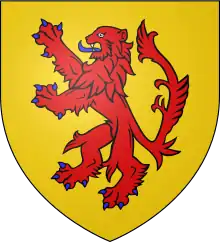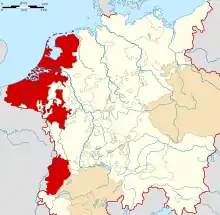Count of Holland
The counts of Holland ruled over the County of Holland in the Low Countries between the 10th and the 16th century.

House of Holland
The first count of Holland, Dirk I, was the son or foster-son of Gerolf, Count in Frisia (Dijkstra suggests that Dirk may have been the son of a sister of Gerolf and that his own father died while he was still an infant). He received land around Egmond from Charles the Fat at a place called Bladella (modern day Bladel near Eindhoven, The Netherlands) in 922. This is seen as the beginning of the county of Holland. However, until about 1100, the usual names for the county were West-Friesland, Frisia or Kennemerland; in spite of this the counts from Dirk I onwards are traditionally named of Holland.
Note that the chronology of the first few counts is uncertain. The existence of a count between Dirk I and Dirk II was only recently suggested, since it is thought that the references to counts named Dirk between 896 and 988 refer to three, not two, different counts. This third Count Dirk is placed between Dirk I and II and numbered as Dirk I bis to avoid confusion with the already established numbering referring to the other counts of Holland named Dirk.
- Gerolf (r. 880 – 896)
- Dirk I (r. 896 – 931)
- Dirk I bis (r. 931 - 939), son of Dirk I
- Dirk II (r. 939 – 988), son of Dirk I bis
- Arnulf (r. 988 – 993), son of Dirk II
- Dirk III Hierosolymita (r. 993 – 1039), son of Arnulf I
- Dirk IV (r. 1039 – 1049), son of Dirk III
- Floris I (r. 1049 – 1061), brother of Dirk IV
- Gertrude of Saxony (regent), widow of Floris I
- Robert the Frisian (regent), second husband of Gertrude
- Godfrey the Hunchback, Duke of Lower Lorraine (regent)
- Dirk V (r. 1061 – 1091), son of Floris I
- Floris II the Fat (r. 1091 – 1121), first to be called 'Count of Holland', son of Dirk V
- Dirk VI (r. 1121 – 1157), son of Floris II
- Floris III (r. 1157 – 1190), son of Dirk VI
- Dirk VII (r. 1190 – 1203), son of Floris III
- Ada (r. 1203 - 1207), daughter of Dirk VII
- Louis II of Loon (r. 1203 - 1207), husband of Ada
- William I (r. 1203 – 1222), brother of Dirk VII
- Floris IV (r. 1222 – 1234), son of William I
- William II (r. 1234 – 1256), King of Germany, son of Floris IV
- Floris de Voogd (r. 1256 - 1258, regent, as guardian for Floris V), brother of William II
- Floris V the Peasants' God (r. 1256 – 1296), son of William II
- John III, Lord of Renesse (r. 1296, regent)
- Wolfert I, Lord of Borselen (r. 1296 - 1299, regent)
- John II, Count of Hainaut (r. 1299 as regent, inherited the county after John I's death, see below)
- John I (r. 1296 – 1299), son of Floris V
House of Avesnes
When John I died childless, the county was inherited by John II of Avesnes, Count of Hainaut from 1299. John of Avesnes was a son of Adelaide of Holland, sister of William II of Holland.
- John II (r. 1299 - 1304), grandson of Floris IV
- William III (r. 1304 - 1337), son of John II
- William IV the Bold (r. 1337 - 1345), son of William III
- Margaret I (r. 1345 - 1354), daughter of William III
House of Wittelsbach
During the rule of Margaret, her son William V had the real power in the county. He became ruler in his own right as a result of the Hook and Cod wars. He was also Duke of Bavaria-Straubing as William I.
- Louis the Bavarian (r. 1345 –1347), Holy Roman Emperor, husband of Margaret
- William V (r. 1354–1388), son of Louis and Margaret
- Albert I (r. 1388–1404), brother of William V
- William VI (r. 1404–1417), son of Albert
- Jacqueline (r. 1417–1432), daughter of William VI
- John III the Pitiless (r. 1417–1425), Duke of Bavaria-Straubing, brother of William VI, rival of Jacqueline
- John IV (House of Leuven) (r. 1418–1427), Duke of Brabant, cousin and husband of Jacqueline
- Humphrey (House of Lancaster) (r. 1422–1425), Duke of Gloucester, husband of Jacqueline
- Francis, Lord of Borselen (r. 1432), husband of Jacqueline
There was a war of succession between John III and Jacqueline. This war was finally won by Philip of Burgundy in 1432, who, in the meantime had inherited John's claims on the county. Philip was a nephew of William VI, who had married a daughter of Philip the Bold of Burgundy. In 1432 he forced Jacqueline to abdicate from Hainaut and Holland on his behalf.
House of Valois
- Philip I the Good (r. 1432-1467), grandson of Albert I
- Charles I the Bold (r. 1467-1477), son of Philip I
- Mary I the Rich (r. 1477-1482), daughter of Charles I
House of Habsburg
- Maximilian (r. 1482-1494, regent), Holy Roman Emperor, husband of Mary I
- Philip II the Handsome (r. 1494-1506), King Philip I of Castile
- Charles II (r. 1515-1555), Holy Roman Emperor Charles V, King of Spain
- Philip III (r. 1555-1581, 1581-1598 titular only), King Philip II of Spain
During the 'foreign rule' by Burgundy and Habsburg, the county was governed by a stadtholder in name of the count. In 1581, the Estates General of the United Provinces declared themselves independent from the Spanish rule of Philip II (who was Philip III of Holland). Until the Treaty of Münster in 1648, the kings of Spain still used the title Count of Holland, but they had lost the actual power over the county to the States of Holland.
Aftermath
The county remained in existence as a constituent member state of the Dutch Republic until 1795. There were no more counts however since the Estates of Holland and West-Frisia were the sovereign of the county (although the countship was offered to William the Silent in 1584, shortly before his death). The stadtholders, who were servants of the Estates, were the de facto chief-executives during this period.
See also
- Counts of Holland family tree
- A book of 32 plates of the counts of Holland published in Amsterdam in 1663, engraved by Adriaen Matham
References
- B. K. S. Dijkstra, Een stamboom in been, Amsterdam 1991.
- Counts of Holland
